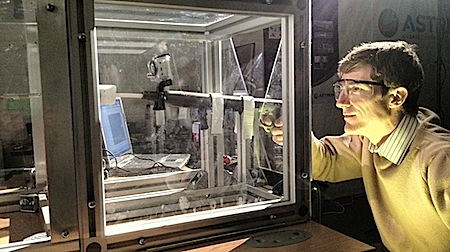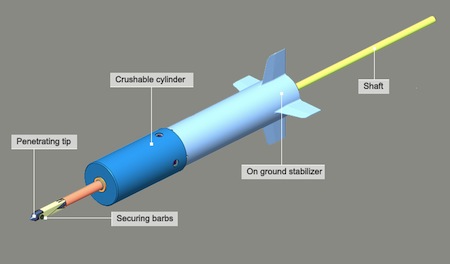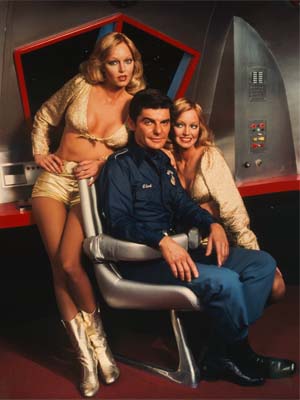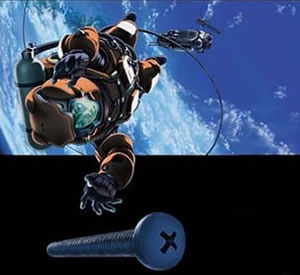Science Fiction
Dictionary
A B C D E F G H I J K L M N O P Q R S T U V W X Y Z
Space Debris Cleanup - Use Harpoons Or Gas Clouds?

Space debris is a real problem; over 22,000 objects are now being tracked in orbit around the Earth. And that doesn't count the estimated 500,000 objects ranging in size between 1-10cm across. How can we clean up some of this junk, which endangers working satellites and the International Space Station?
Two new methods were proposed last week. UK engineers led by Dr Jaime Reed, from Astrium UK, are developing a kind of harpoon mounted on a chaser satellite.

(Space harpoon designed by Dr. Jaime Reed)
Dr Reed's proposal is for a barbed spear about 30cm in length. It would be mounted on a "chaser satellite" that would edge to within 100m of a junk object.Pictures sent to the ground would then be used to assess the target, before the chaser was moved to within perhaps 20m to take a shot.
Once the harpoon is hooked through the skin of the rogue satellite or rocket stage, the chaser could either pull on a trailing polymer cord itself or deploy a separate thruster unit to do the job of dragging the aimless drifter towards Earth.

(Space harpoon diagram)
Another new method has been suggested by Boeing. The Boeing engineers suggest hastening orbital decay of space debris by creating a transient gaseous cloud with enough density to slow debris enough to make it fall into Earth's atmosphere.
Boeing has applied for a patent for its idea:
SUMMARY[0004] According to an aspect herein, a method comprises removing space debris having a relatively low ballistic coefficient by hastening orbital decay of the debris. A transient gaseous cloud is created at an altitude of at least 100 km above Earth. The cloud has a density sufficient to slow the debris so the debris falls into Earth's atmosphere.
[0005] According to another aspect herein, a method for removing space debris having a relatively low ballistic coefficient comprises performing a Prandtl-Meyer expansion of gas into a gaseous cloud at an altitude of at least 100 km above Earth. The cloud has a density sufficient to slow the space debris so the debris falls into Earth's atmosphere. The cloud does not target any specific debris.
[0006] According to another aspect herein, an apparatus for creating a transient gaseous cloud comprises an expellant including at least one of the following: a burn metal of higher atomic weight than aluminum fuel; a cryogenic noble gas; a heavy molecular fluid having a low isentropic exponent; and high-atomic-weight elements and halogens. The apparatus further comprises a gas generator for generating a gas from the expellant, and a nozzle for expanding the gas into a gaseous cloud.
Science fiction writers of all sorts, in a variety of media, have been sounding the warning about space debris for generations, and placing the solutions into popular culture where they can be part of the lives of engineers and policymakers.
For example, consider the 1977 television series Quark. This comedy, created by legendary writer Buck Henry, described the activities of the United Galaxies Sanitation Patrol Cruiser, an interstellar garbage scow.

(Richard Benjamin and the Barnstable twins)
Richard Benjamin played Adam Quark, who worked to clean up trash in space. He is ably assisted by the Bettys, played by the Doublemint twins (Cyb and Patricia Barnstable).
In his 1978 novel The Fountains of Paradise, Arthur C. Clarke uses Operation Cleanup to make sure that low earth orbit is clear of debris for the newly constructed space elevator.
Fortunately, the old orbital forts were superbly equipped for this task. Their radars - designed to locate oncoming missles at extreme ranges with no advance warning - could easily pinpoint the debris of the early Space Age. Then their lasers vaporized the smaller satellites, while the larger ones were nudged into higher and harmless orbits.
Fans may also recall Planetes, an anime series published by Makoto Yakimura in Japan starting in 1999. The series follows a team of debris cleaners who clear space junk from flight paths.

Planetes cover art
Update 03-Mar-2017: See also the helix gun used to gather meteors from Salvage in Space (1933) by Jack Williamson.
See also NanoTerminator Prevents Annoying Space Debris Build-Up and Debris Cloud From Chinese ASAT A Menace To Space Lanes. Via Boeing's Space Debris Removal patent application and UK design to 'harpoon' old satellites at BBC.
Scroll down for more stories in the same category. (Story submitted 10/6/2012)
Follow this kind of news @Technovelgy.| Email | RSS | Blog It | Stumble | del.icio.us | Digg | Reddit |
Would
you like to contribute a story tip?
It's easy:
Get the URL of the story, and the related sf author, and add
it here.
Comment/Join discussion ( 0 )
Related News Stories - (" Space Tech ")
Will Space Stations Have Large Interior Spaces Again?
'They filed clumsily into the battleroom, like children in a swimming pool for the first time, clinging to the handholds along the side.' - Orson Scott Card, 1985.
Reflect Orbital Offers 'Sunlight on Demand' And Light Pollution
'I don't have to tell you about the seven two-mile-diameter orbital mirrors...'
Chrysalis Generation Ship to Alpha Centauri
'This was their world, their planet —
this swift-traveling, yet seemingly moveless vessel.' - Nat Schachner, 1934
The First Space Warship For Space Force
'Each of the electrical ships carried about twenty men...' - Garrett P. Serviss, 1898.
Technovelgy (that's tech-novel-gee!) is devoted to the creative science inventions and ideas of sf authors. Look for the Invention Category that interests you, the Glossary, the Invention Timeline, or see what's New.
Science Fiction
Timeline
1600-1899
1900-1939
1940's 1950's
1960's 1970's
1980's 1990's
2000's 2010's
Current News
Natural Gait With Prosthetic Connected To Nervous System
'The leg was to function, in a way, as a servo-mechanism operated by Larry’s brain...'
Woman Marries Computer, Vonnegut's Dream Comes True
'Men are made of protoplasm... Lasts forever.'
Spidery 'Walk Me' Toyota Autonomous Wheel Chair Like Star Wars
Walk along with the emperor.
Dancing Robots Taught Dance Moves
'A clockwork figure would be the thing for you...'
Proof Of Robothood - Not A Person
'Who are you people? - Show 'em.'
Indonesian Clans Battle
'The observation vehicle was of that peculiar variety used in conveying a large number of people across rough terrain.'
The 'Last Mile' In China Crowded With Delivery Robots
Yes, it's a delivery robot. On wheels.
Tornyol Microdrone Kills Mosquitoes
'The real border was defended by... a swarm of quasi-independent aerostats.'
PLATO Spacecraft, Hunter Of Habitable Planets, Now Ready
'I ... set my automatic astronomical instruments to searching for a habitable planet.'
Factory Humanoid Robots Built By Humanoid Robots
'...haven't you a section of the factory where only robot labor is employed?'
iPhone Air Fulfils Jobs' Promise From 2007 - A Giant Screen!
'... oblongs were all over the floor and surfaces.'
ChatGPT Now Participates in Group Chats
'...the city was their laboratory in human psychology.'
iPhone Pocket All Sold Out!
'A long, strong, slender net...'
Did The Yautja Have These First?
What a marvel of ingenuity the little device was!
Jetson ONE Air Races Begin, Can Air Polo Be Far Behind?
'If you're one of those rarities who haven't attended a rocket-polo "carnage", let me tell you it's a colorful affair.'
Will Space Stations Have Large Interior Spaces Again?
'They filed clumsily into the battleroom, like children in a swimming pool for the first time, clinging to the handholds along the side.'
